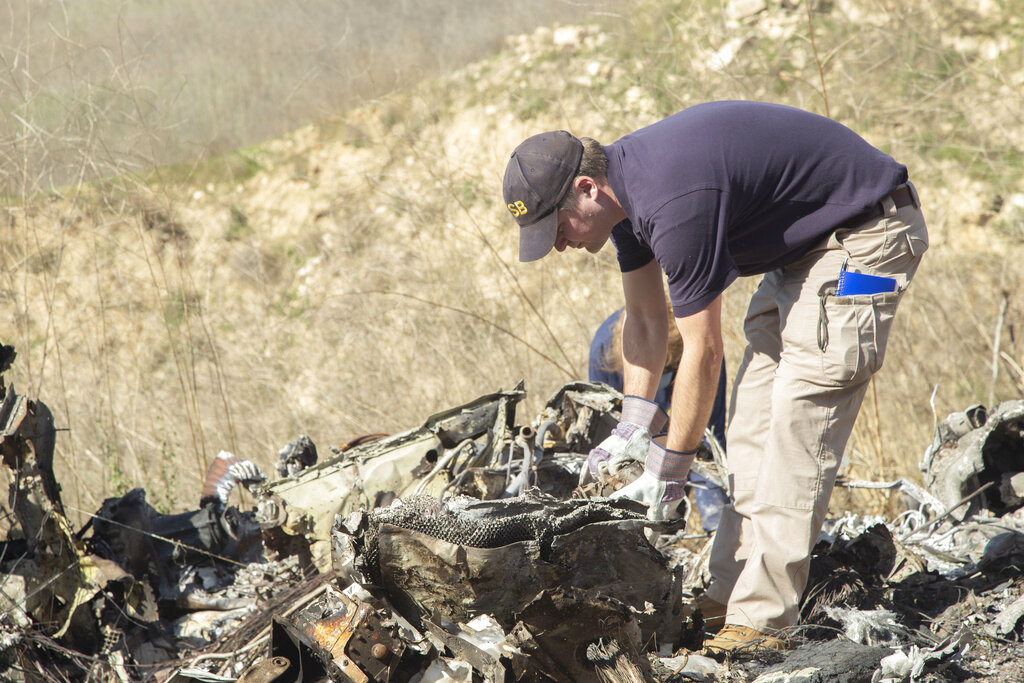Kobe Bryant’s death throws spotlight on crash-warning system

National Transportation Safety Board investigators Adam Huray, foreground, and Carol Hogan examine wreckage as part of the NTSB’s investigation of a helicopter crash near Calabasas, California. (National Transportation Safety Board via AP)
LOS ANGELES — A cockpit warning system to help helicopters avoid crashes would not necessarily have saved Kobe Bryant’s life, and regulators and pilots alike have expressed concern that the instrument can trigger too many false alarms that can prove distracting.
“Another warning system screaming at you isn’t going to help,” said Brian Alexander, a helicopter pilot and aviation lawyer. “You don’t want to inundate the pilot.”
National Transportation Safety Board officials say it is too early to tell whether a warning system missing on Bryant’s Sikorsky helicopter could have prevented the crash. But they think it should have been installed on the aircraft, and they criticized federal regulators for not carrying out the NTSB’s recommendations years ago to require the equipment on helicopters.
At issue is what’s known as a Terrain Awareness and Warning System, or TAWS, which would have sounded a cockpit alarm if the aircraft was in danger. It is required in medical helicopters but not in commercial helicopters like the one used by Bryant.
The crash Sunday that killed the basketball superstar and eight others has highlighted the debate over the merits of the system, which some pilots believe is unnecessary and refer to its warnings as “nuisance alarms.”
Peter Goelz, a former managing director of the NTSB, said there is “no reasonable excuse” for the system not to be installed on all choppers.
“From a safety perspective, you want all the safety enhancements that are available,” he said. “The trade-off is worth it.”
The NTSB recommended that the Federal Aviation Administration require the system after a Sikorsky S-76A carrying workers to an offshore drilling ship, crashed in the Gulf of Mexico near Galveston, Texas, killing all 10 people aboard in 2004. Ten years later, the FAA mandated such systems on air ambulances only.
FAA officials had questioned the value of such technology on helicopters, which tend to fly close to buildings and the ground and could trigger too many alarms that might distract the pilot.
The pilot in Sunday’s crash, Ara Zobayan, had been climbing out of the clouds when the chartered aircraft went into a sudden and terrifying 1,200-foot (366-meter) descent that lasted nearly a minute, investigators said Tuesday. It slammed into a fog-shrouded hillside, scattering debris more than 500 feet (150 meters).
Bill English, investigator in charge of the NTSB’s Major Investigations Division, said it was not clear yet whether “TAWS and this scenario are related to each other.”
Pilot Bernard Raysor said the systems have improved over the years so they don’t always go off all the time, and one of them may have prevented him from crashing as he and another pilot were trying to land on a hospital helipad in Little Rock, Arkansas, over a decade ago.
“The TAWS alert went off: ‘Obstacle! Pull up! Obstacle! Pull up!’” he recalled. “We looked at each other like `What is this got to be?’” Then he looked around, and saw it: A radio tower whose lights had gone out.
“I can’t say we would have hit it, but it was closer than comfortable,” he said.